翻译技巧 词类转换法共30页文档
- 格式:ppt
- 大小:3.00 MB
- 文档页数:30
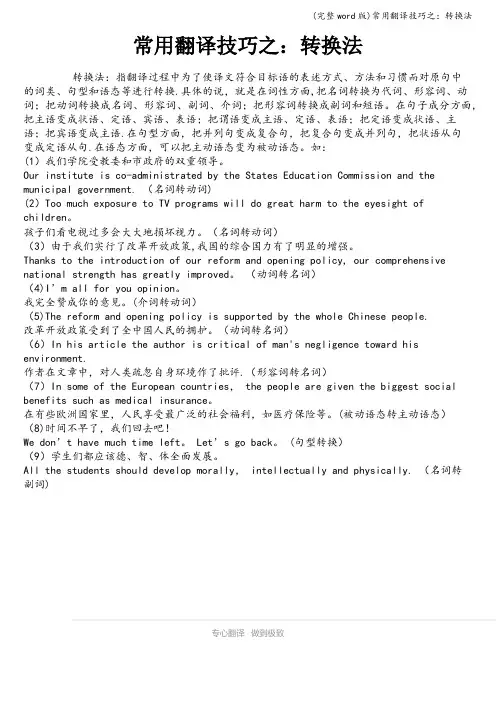
(完整word版)常用翻译技巧之:转换法常用翻译技巧之:转换法转换法:指翻译过程中为了使译文符合目标语的表述方式、方法和习惯而对原句中的词类、句型和语态等进行转换.具体的说,就是在词性方面,把名词转换为代词、形容词、动词;把动词转换成名词、形容词、副词、介词;把形容词转换成副词和短语。
在句子成分方面,把主语变成状语、定语、宾语、表语;把谓语变成主语、定语、表语;把定语变成状语、主语;把宾语变成主语.在句型方面,把并列句变成复合句,把复合句变成并列句,把状语从句变成定语从句.在语态方面,可以把主动语态变为被动语态。
如:(1)我们学院受教委和市政府的双重领导。
Our institute is co-administrated by the States Education Commission and the municipal government. (名词转动词)(2)Too much exposure to TV programs will do great harm to the eyesight of children。
孩子们看电视过多会大大地损坏视力。
(名词转动词)(3)由于我们实行了改革开放政策,我国的综合国力有了明显的增强。
Thanks to the introduction of our reform and opening policy, our comprehensive national strength has greatly improved。
(动词转名词)(4)I’m all for you opinion。
我完全赞成你的意见。
(介词转动词)(5)The reform and opening policy is supported by the whole Chinese people.改革开放政策受到了全中国人民的拥护。
(动词转名词)(6)In his article the author is critical of man's negligence toward his environment.作者在文章中,对人类疏忽自身环境作了批评.(形容词转名词)(7)In some of the European countries, the people are given the biggest social benefits such as medical insurance。
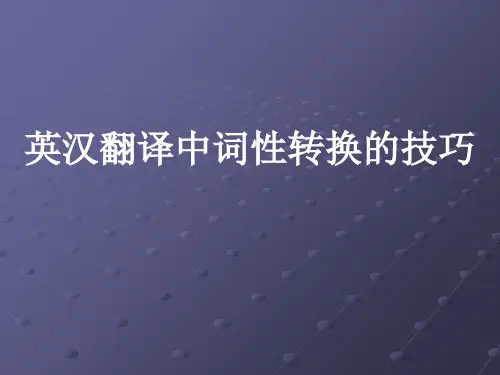

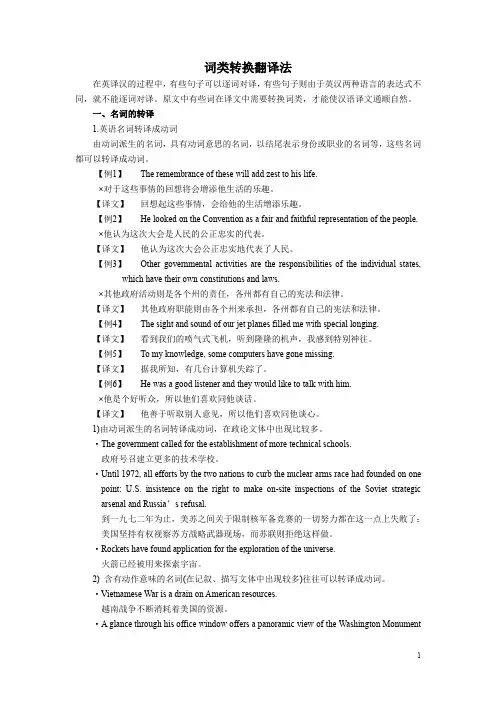
词类转换翻译法在英译汉的过程中,有些句子可以逐词对译,有些句子则由于英汉两种语言的表达式不同,就不能逐词对译。
原文中有些词在译文中需要转换词类,才能使汉语译文通顺自然。
一、名词的转译1.英语名词转译成动词由动词派生的名词,具有动词意思的名词,以结尾表示身份或职业的名词等,这些名词都可以转译成动词。
【例1】The remembrance of these will add zest to his life.×对于这些事情的回想将会增添他生活的乐趣。
【译文】回想起这些事情,会给他的生活增添乐趣。
【例2】He looked on the Convention as a fair and faithful representation of the people.×他认为这次大会是人民的公正忠实的代表。
【译文】他认为这次大会公正忠实地代表了人民。
【例3】Other governmental activities are the responsibilities of the individual states, which have their own constitutions and laws.×其他政府活动则是各个州的责任,各州都有自己的宪法和法律。
【译文】其他政府职能则由各个州来承担,各州都有自己的宪法和法律。
【例4】The sight and sound of our jet planes filled me with special longing.【译文】看到我们的喷气式飞机,听到隆隆的机声,我感到特别神往。
【例5】To my knowledge, some computers have gone missing.【译文】据我所知,有几台计算机失踪了。
【例6】He was a good listener and they would like to talk with him.×他是个好听众,所以他们喜欢同他谈话。
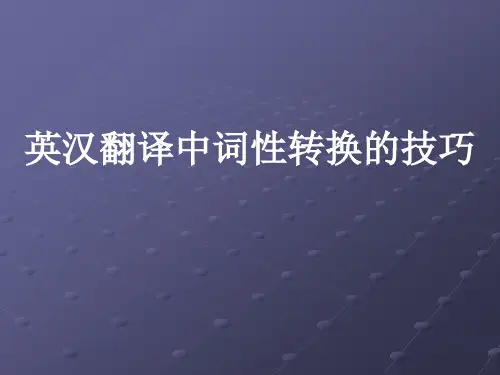
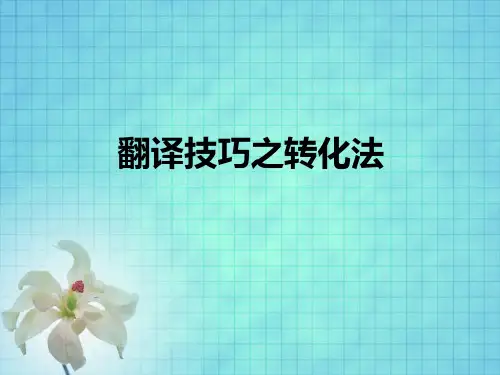
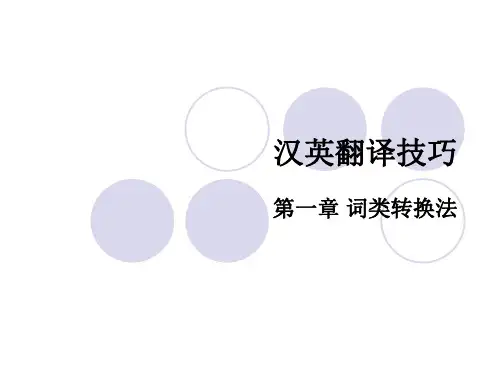
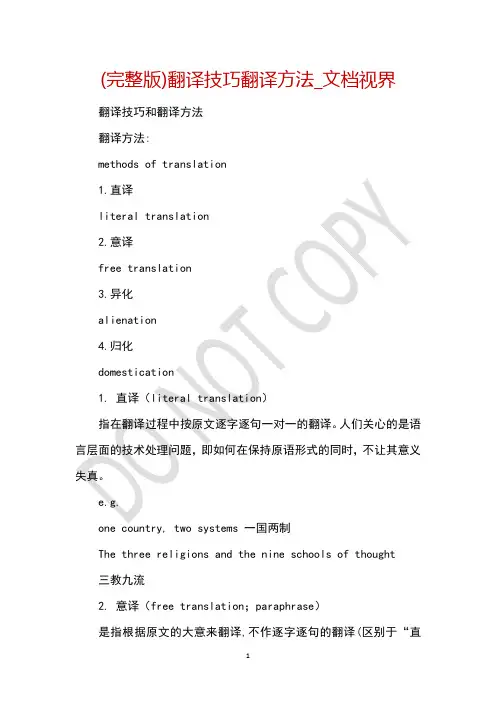
(完整版)翻译技巧翻译方法_文档视界翻译技巧和翻译方法翻译方法:methods of translation1.直译literal translation2.意译free translation3.异化alienation4.归化domestication1. 直译(literal translation)指在翻译过程中按原文逐字逐句一对一的翻译。
人们关心的是语言层面的技术处理问题,即如何在保持原语形式的同时,不让其意义失真。
e.g.one country, two systems 一国两制The three religions and the nine schools of thought 三教九流2. 意译(free translation;paraphrase)是指根据原文的大意来翻译,不作逐字逐句的翻译(区别于“直译”)。
通常在翻译句子或词组(或更大的意群)时使用较多,意译主要在原语与译语体现巨大文化差异的情况下得以应用.从跨文化语言交际和文化交流的角度来看,意译强调的是译语文化体系和原语文化体系的相对独立性。
e.g.Don’t cross the bridge till you get to it.不必过早地担心。
(不必自寻烦恼)Do you see any green in my eye?你以为我是好欺骗的吗?Don’t lock the stable door after the horse has been stolen.直译:不要等马被盗后,才去锁马厩门。
意译:亡羊补牢。
直译和意译的区别1. It’ s a Smoke Free Area.直译:它是个自由吸烟区。
意译:它是个无烟区。
2. Shakespeare put his hometown on the map.直译:莎士比亚把他的家乡放在了地图上。
意译:莎土比亚使他的家乡声名远扬。
3. John would not come out of his shell and talk to others at theparty.直译:晚会上,约翰不愿从壳里钻出来与其他人说话。